Previous Chapter « Table of Contents » Next Chapter
Though they differ by project, a few of the primary goals for revegetation include:
A sustainable roadside landscape is one that is designed, constructed, and maintained with the objective of long-term plant survival while minimizing resource input. This section highlights strategies that help balance long-term maintenance of vegetation to achieve sustainable outcomes. High-level strategies are outlined in this guidebook; more detailed revegetation approaches are provided in FHWA's Roadside Revegetation: An Integrated Approach to Establishing Native Plants (2007).
For purposes of this guidebook, revegetation is defined as the process of planting on disturbed areas following roadway construction. Often, the goals for a project's revegetation efforts are to help minimize the visual impact of construction and to help blend the roadside back into the existing landscape. Additional benefits that revegetation provides include:
Minimizing resource input typically involves selecting native or naturalized plants that are adapted for survival to the local climate, elevation, and soil conditions. If a naturalized plant is used, care must be taken to ensure that it does not have invasive or negative interaction with the native ecosystem. Detailed understanding of the site is helpful to evaluate microclimates, solar aspects, soils, and hydrologic patterns that can provide additional clues to the correct selection of plants. For instance, local native vegetation may be the preferred choice on a project with both north- and south-facing slopes. However, that same native plant may require full sun and well drained soils and thus may not establish on the north-facing slope. Decision-making needs to be flexible enough to choose the most appropriate plants with the greatest chance of survival and growth.
There is not a one-size-fits-all solution to revegetation projects, especially for the roadside. Therefore, an understanding of the particular site conditions and also of plant species and communities is critical in the development of a sustainable revegetation plan. With early collaboration between design disciplines and a clear understanding of the project objectives, a functional and aesthetically appropriate revegetation plan can be developed and can help minimize unnecessary maintenance and plant replacement costs. Figure shows the project cycle of revegetation from planning and programming through maintenance.
This section identifies the traditional process of revegetation. First, existing conditions of the site must be inventoried and incorporated into the revegetation plan. The selected plant material for a sustainable roadside revegetation project should be able to establish and survive with as little outside support as possible, such as irrigation and fertilizers, although these can be critical for success in establishing the plant material. The key is to minimize the intensity and dependence on these resources. To help minimize plant mortality rates, the designer must have a solid grasp of the local native and naturalized plant palette. Understanding soil types, solar conditions, hydrologic regime, and beneficial companion plants will provide a greater opportunity for success as the plants become established. A strong understanding of the attributes of vegetation types can help minimize the need for excess irrigation and replacement. The following must be understood from site evaluation and engineering plans:
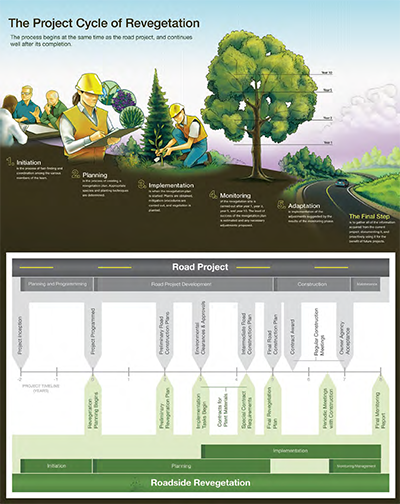
View larger version of Figure 3-22
Figure 3-22: Project cycle of revegetation
Soil information is critical to the creation of successful revegetation plans yet is often unavailable or not considered in the engineering plans. In order to maximize the chances of plant survival, the designer must know the type and condition of the soils where the vegetation will be installed. Coordination with the project engineering staff is needed to determine whether topsoil will be salvaged, stockpiled, or reused.
 VEGETATION AND SAFETY
VEGETATION AND SAFETY
According to the American Association of State Highway and Transportation Officials (AASHTO) Roadside Design Guide (2006), trees are the most commonly struck objects in serious roadside collisions. Crash severity is closely correlated with the speed of vehicles. High-speed roadways should have clear zones free of trees and other fixed object hazards. FHWA encourages highway agencies to work cooperatively with communities to improve safety while enhancing the environment by developing consensus policies related to tree planting, potential removal, or avoidance mitigation. When designing a new roadway tree mitigation measures can include:
Roadway agencies have a responsibility to maintain vegetation at the roadside. Tall or unmanaged vegetation can obscure driver sight lines, traffic signs and signals, other vehicles, pedestrians, bicyclists, and wildlife. Avoidance of edible vegetation on the roadside edge can help discourage animals from foraging at the roadside and help reduce the potential for vehicle/wildlife collisions (AASHTO, 2006).
If topsoil is to be reused on the project, considerations should include:
If existing topsoil is limited, furnished topsoil or topsoil manufactured on the project site should be considered.
Soil samples should be taken and sent to a soils laboratory to analyze the organic and mineral composition of the soils. This will help indicate any soil treatments necessary prior to plant and seeding operations. If the soils are optimized in the most cost-effective manner, vegetation will have a better chance of establishment and survival versus simply planting or seeding on the existing soils. Although there are costs associated with soil testing and the use of soil amendments, having this information prior to plant installation can save long-term costs associated with revegetation. Beyond plant materials and project site conditions, another key requirement is communication and collaboration among other disciplines early in the design process. This promotes an understanding of the different project goals and objectives as seen by each group. Early communication and collaboration provides the opportunity for open discussion and the identification of conflicts.
Although thriving vegetation can indicate a healthy roadside ecosystem, it is only one part of the roadside environment. The following are examples of the ways in which revegetation can integrate with other disciplines:
![]() AESTHETICS: Vegetation plays a key role in achieving an aesthetically pleasing road- side environment. Proper selection of plant materials as well as their placement, either individually or in groupings, can make the difference in achieving the desired aesthetic. Aesthetic goals for the project should be defined, especially if there are areas of the project that require screening or views that could be highlighted and framed with vegetation. For instance, it may not make sense for a tightly spaced row of evergreen trees to be planted where they may block views. Proper placement of the plants during the design phase (and an understanding of growth, change, and effect over time) as well as field adjustment of plant placement can help enhance the aesthetic quality.
AESTHETICS: Vegetation plays a key role in achieving an aesthetically pleasing road- side environment. Proper selection of plant materials as well as their placement, either individually or in groupings, can make the difference in achieving the desired aesthetic. Aesthetic goals for the project should be defined, especially if there are areas of the project that require screening or views that could be highlighted and framed with vegetation. For instance, it may not make sense for a tightly spaced row of evergreen trees to be planted where they may block views. Proper placement of the plants during the design phase (and an understanding of growth, change, and effect over time) as well as field adjustment of plant placement can help enhance the aesthetic quality.
The intensity of landscape treatments should be based on the roadway characteristics. In slow-speed zones and rest areas (turnouts, scenic vistas, etc.), a more detailed approach to plantings is needed. Site-specific slope molding, rock cut sculpturing, and diverse vegetation types can help enhance the roadside environment and provide added interest for the highway user (FHWA PDDM, 2011).1 On high-speed sections of roadways, vegetation should create interest for motorists but not at an intensity that is distracting.
![]() GEOTECH: The revegetation and geotechnical disciplines need to coordinate placement of vegetation on roadside slopes and along roadside structures. Enhancing roadside slopes and cuts can help mimic natural environmental and aesthetic conditions. The addition of boulders, stumps, and logs on cut and fill slopes (outside of the clear zone) can help replicate the natural appearance and function of the area.2
GEOTECH: The revegetation and geotechnical disciplines need to coordinate placement of vegetation on roadside slopes and along roadside structures. Enhancing roadside slopes and cuts can help mimic natural environmental and aesthetic conditions. The addition of boulders, stumps, and logs on cut and fill slopes (outside of the clear zone) can help replicate the natural appearance and function of the area.2
![]() HYDRAULIC DESIGN: Another relationship to consider is integration with drainage plans. A sustainable system will minimize the resources spent on the establishment and maintenance of vegetation. If vegetation is to be used in and near drainage areas, then vegetation should be selected that will withstand the hydraulic conditions. Plants that can tolerate periodic inundation and flowing water need to be selected for use near drainages.
HYDRAULIC DESIGN: Another relationship to consider is integration with drainage plans. A sustainable system will minimize the resources spent on the establishment and maintenance of vegetation. If vegetation is to be used in and near drainage areas, then vegetation should be selected that will withstand the hydraulic conditions. Plants that can tolerate periodic inundation and flowing water need to be selected for use near drainages.
Plants that are more adapted to xeric (dry) conditions may not tolerate wet conditions and could require replacement. However, riparian-adapted plants such as willow that is planted in dry conditions, far from a water source may require supplemental irrigation to survive if they do not receive adequate water. Vegetation near drainage ways may need to be cleared if it is inhibiting the flow of water through the system. A choked out ditch can cause flooding on the roadway, leading to safety and, potentially, erosion issues.
The examples provided in this section are not an exhaustive list of the different relationships between revegetation and other disciplines. It does, however, support the need to focus on the interrelationships between disciplines when designing a sustainable roadside.
Case Study
USE OF VEGETATED INFILTRATION SWALES ON THE INTERCOUNTY CONNECTOR
The Intercounty Connector (ICC) is a new 18-mile roadway near Washington, D.C. The design-build contractor was encouraged to incorporate measures of conservation and sustainability within the project limits. The corridor incorporates innovative roadside revegetation practices including the use of:
An interesting practice on the ICC that has multiple benefits is vegetated biofiltration swales, a water quality improvement feature of the highway. The ICC is within the Chesapeake Bay Watershed where surface water quality is a major concern. Additionally, these swales are located in an area designated as a Special Protection Area by the local county. The swales filter, cool, and infiltrate run-off stormwater from the highway before excess run-off is released into high quality local streams located within forested parkland that is crossed by the highway. The biofiltration swales consist of a bioretention soil mix (BSM) that is composed primarily of sand, along with soil and organic matter to accommodate plant growth. Gravel "windows" within the BSM surface allow water run-off to quickly drain through a sand layer before entering filtration, drainage, and infiltration layers. Excess run-off drains via a perforated underdrain pipe in the drainage layer to underground, slow-release holding tanks that discharge to the nearby stream. This process helps to ensure that the water temperature in the stream does not increase, which in turn helps maintain healthy habitat for aquatic species. Due to the extreme wet or dry conditions of the BSM, switchgrass (Panicum virgatum) was chosen as the vegetation cover for the biofiltration swales. The fibrous roots of switchgrass are anticipated to stabilize the soil without inhibiting percolation.
The Maryland State Highway Administration is responsible for designing and constructing the project, and FHWA is a sponsoring agency. The project is owned and operated by the Maryland Transportation Authority.
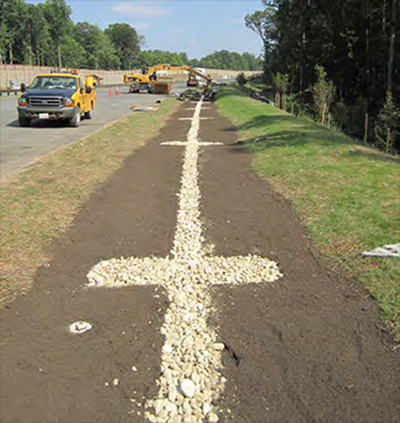
Infiltration swale during construction
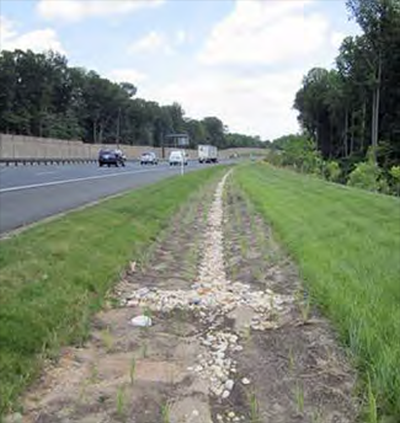
Infiltration swale after construction
Project website: www.iccproject.com
There are many trade-offs to consider when developing a revegetation plan, such as safety, maintenance, aesthetics, and establishment issues. The following examples are common ones that arise in the design process. They pertain to plant mortality costs, methods to control noxious weeds, and differences in opinion related to aesthetics.

View larger version of Figure 3-23
Figure 3-23: Trade-off example: controlling noxious weeds
STEP BY STEP GUIDE TO CREATING A VEGETATION PLAN:
The approach to developing a sustainable roadside revegetation plan should begin with a clear understanding of the project goals and how the plans will meet the overall project objectives. Having a landscape architect or revegetation specialist on the project who has advanced knowledge of native and naturalized plant materials is an important part of the design process. Vegetation expertise should include knowledge of grasses, perennials, trees, shrubs, groundcovers, wetland vegetation, and soils. The greater the designer's understanding and knowledge of the plant palette, the greater the chance of successful plant selection for the given conditions on the site. This knowledge will also enhance the vegetation's long-term survival and minimize the risk of selecting plants with high-maintenance requirements.
In addition to plant knowledge, a thorough understanding of the existing and proposed site conditions is important. This knowledge helps designers site the correct plants in proper locations and helps minimize the probability of spending resources on plant replacement. In addition, having a thorough understanding of the project site will help inform the designer of the other disciplines' roles in the project so productive discussions can begin during inter-disciplinary project coordination meetings.
Construction activities for roadside restoration and revegetation should create a platform for healthy and successful vegetation growth by producing successful soil conditions. Correct soil preparation encourages full plant establishment with rapid canopy coverage, providing vegetative cover and helping control weeds. Plant care during the construction process is crucial to plant establishment.
Case Study
STATE ROUTE 76 (SR-76) PROJECTS
CALIFORNIA DEPARTMENT OF TRANSPORTATION (CALTRANS)
The SR-76 project is widening and realigning an existing highway which connects the Interstate 5 and the Interstate 15 (I-5 and I-15) corridors in northern San Diego County. The project is funded by TransNet, a voter-approved half-cent sales tax for transportation projects in the San Diego region. The TransNet program includes an innovative Environmental Mitigation Program (EMP), which provides $850 million to protect, preserve, and restore habitats near major TransNet-funded transportation projects, including the SR 76 corridor. Instead of mitigating impacts project-by-project, the EMP allows land to be acquired in advance of projects in larger parcels and at lower costs so that habitat areas can be protected and restored earlier.
The EMP has slated $80 million to protect, preserve, and restore habitat adjacent to the SR 76 corridor between I-5 and I-15. To date, 236 acres of freshwater wetlands and 1,356 acres of upland vegetation have been preserved. In total, close to 1,600 acres of property have been purchased to support habitat conservation and the San Luis Rey River Park Plan in this corridor.
By acquiring and restoring unique habitat areas along SR 76, key populations of endangered species will be preserved, land adjacent to existing conserved habitat areas will be connected, and wildlife linkages will be created. The images taken during construction show a sampling of the new wildlife crossings along the corridor.
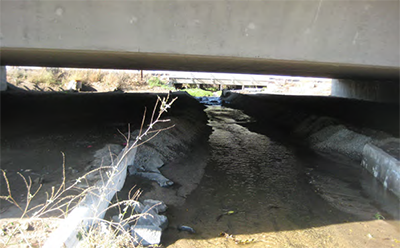
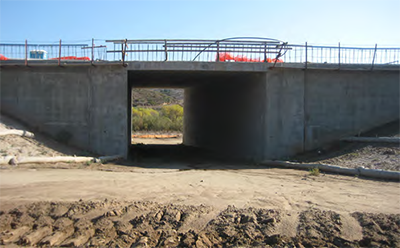
Case Study
SYLVAN PASS
YELLOWSTONE NATIONAL PARK
Construction of a 7-mile segment of the East Entrance Road from the Park entrance to Sylvan Pass began in 2004 as part of a parkwide road improvement program to reconstruct roadways to a 30-foot width.
According to FHWA, "the context-sensitive design of this project includes widening a historic road to accommodate visitors and modern vehicles; providing for wildlife viewing without blocking traffic; protecting vertical wetlands native vegetation and bear trails; and including special rails and rock- sculpting used to maintain rustic and natural aesthetics."
Steep slopes affected by the construction near the pass made it difficult for wildlife to cross. Gentle vegetated slopes were built at certain sections which allowed wildlife to cross easily. Trees were placed parallel to the roadway to assist wildlife in climbing slopes and to limit erosion.
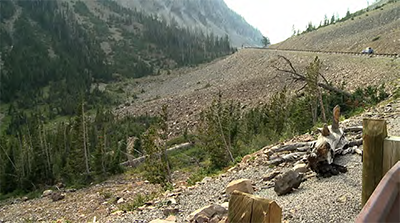
Vegetated slopes along the roadway create pathways for wildlife
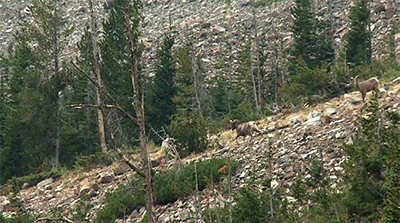
Pair of bighorn sheep utilize the vegetated slope
1. FHWA PDDM: Section 9.5.4 Landscaping and Restoration of Vegetation, pp 9-145.
2. FHWA PDDM: Section 9.5.4.7 Slope Enhancements